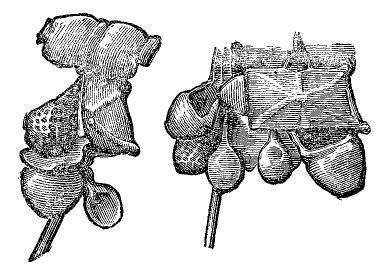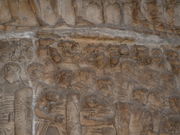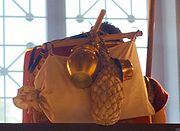.gif)
Sarcina (marching pack)
Encyclopedia



Legionary
The Roman legionary was a professional soldier of the Roman army after the Marian reforms of 107 BC. Legionaries had to be Roman citizens under the age of 45. They enlisted in a legion for twenty-five years of service, a change from the early practice of enlisting only for a campaign...
, the heavy infantry of the Roman legion
Roman legion
A Roman legion normally indicates the basic ancient Roman army unit recruited specifically from Roman citizens. The organization of legions varied greatly over time but they were typically composed of perhaps 5,000 soldiers, divided into maniples and later into "cohorts"...
s.
Most of a legionary's equipment other than his arms and armour would, in early times, have been consigned to a baggage train and borne by mules and carts. http://www.mfa.org/collections/search_art.asp?recview=true&id=153731&coll_keywords=pack&coll_accession=&coll_name=&coll_artist=&coll_place=&coll_medium=&coll_culture=&coll_classification=&coll_credit=&coll_provenance=&coll_location=&coll_has_images=&coll_on_view=&coll_sort=0&coll_sort_order=0&coll_package=0&coll_start=1Image of pack donkey on a Greek wine cup circa 480 BC, Museum of Fine Arts, Boston.]
However, following the reforms of the Roman General Gaius Marius
Gaius Marius
Gaius Marius was a Roman general and statesman. He was elected consul an unprecedented seven times during his career. He was also noted for his dramatic reforms of Roman armies, authorizing recruitment of landless citizens, eliminating the manipular military formations, and reorganizing the...
, the soldiers were expected to carry much of their rations and equipment themselves. This was done to reduce the size of the baggage train and increase the mobility of the army by allowing the soldiers to move strategically (i.e. quickly) independently of the train. Such was the load of the soldiers that they became known as Marius' Mules.
The appearance of the marching pack is known from illustrations on Trajan's Column
Trajan's Column
Trajan's Column is a Roman triumphal column in Rome, Italy, which commemorates Roman emperor Trajan's victory in the Dacian Wars. It was probably constructed under the supervision of the architect Apollodorus of Damascus at the order of the Roman Senate. It is located in Trajan's Forum, built near...
. Here it can be seen that a legionary's sarcina was carried on a pole called a furca and would have included:
- LoculusLoculus (satchel)Loculus is a Latin word literally meaning little place and was used in a number of senses including to indicate a satchel. Satchels were carried by Roman legionaries, as a part of their sarcina or luggage....
- a satchel - Cloak bag
- Cooking pot
- PateraPateraA patera was a broad, shallow dish used for drinking, primarily in a ritual context such as a libation. These paterae were often used in Rome....
- mess tin - Netted object
However, this was certainly not the limit of the soldiers load. Time and again, Roman writers emphasise the importance of soldiers being self-sufficient and not tied to the baggage train.
The 2nd century historian Appian of Alexandria
Appian
Appian of Alexandria was a Roman historian of Greek ethnicity who flourished during the reigns of Trajan, Hadrian, and Antoninus Pius.He was born ca. 95 in Alexandria. He tells us that, after having filled the chief offices in the province of Egypt, he went to Rome ca. 120, where he practised as...
records the actions of Scipio Aemilianus Africanus
Scipio Aemilianus Africanus
Publius Cornelius Scipio Aemilianus Africanus Numantinus , also known as Scipio Aemilianus or Scipio Africanus the Younger, was a leading general and politician of the ancient Roman Republic...
in late 3rd century BC. This was mainly with the objective of improving the morale of the soldiers, but it is also clear that the army is expected to be mobile:
- He ordered all wagons and their superfluous contents to be sold, and all pack animals, except such as he designated, to remain. For cooking utensils it was permitted to have only a spit, a brass kettle, and one cup. Their food was limited to plain boiled and roasted meats. They were forbidden to have beds, and Scipio was the first one to sleep on straw. He forbade them to ride on mules when on the march; "for what can you expect in a war," said he, "from a man who is not able to walk?" Those who had servants to bathe and anoint them were ridiculed by Scipio, who said that only mules, having no hands, needed others to rub them.
The 1st century historian Josephus
Josephus
Titus Flavius Josephus , also called Joseph ben Matityahu , was a 1st-century Romano-Jewish historian and hagiographer of priestly and royal ancestry who recorded Jewish history, with special emphasis on the 1st century AD and the First Jewish–Roman War, which resulted in the Destruction of...
, recorded the items carried in his own time:
- ...besides a saw and a basket, a pick-axe and an axe, a thong of leather and a hook, with provisions for three days, so that a footman hath no great need of a mule to carry his burdens. The Wars Of The Jews Book 3, chapter 7.
The 4th century writer Vegetius
Vegetius
Publius Flavius Vegetius Renatus, commonly referred to simply as Vegetius, was a writer of the Later Roman Empire. Nothing is known of his life or station beyond what he tells us in his two surviving works: Epitoma rei militaris , and the lesser-known Digesta Artis Mulomedicinae, a guide to...
advises that:
- The legion is provided with iron hooks, called wolves, and iron scythes fixed to the ends of long poles; and with forks, spades, shovels, pickaxes, wheelbarrows and baskets for digging and transporting earth; together with hatchets, axes and saws for cutting wood. De Re Militari Book II: The Organization of the Legion.
Vegetius was not clear that the soldiers were required to carry these items personally, but we know that soldiers were required to carry entrenching tools (such as the dolabra
Dolabra
The dolabra is a versatile tool used by the people in Italy since ancient times. The dolabra could serve as a pickaxe used by miners and excavators, a priest's implement for ritual religious slaughtering of animals and as an entrenching tool used in Roman infantry tactics....
) and turf cutters for the construction of a temporary camp
Castra
The Latin word castra, with its singular castrum, was used by the ancient Romans to mean buildings or plots of land reserved to or constructed for use as a military defensive position. The word appears in both Oscan and Umbrian as well as in Latin. It may have descended from Indo-European to Italic...
at the end of each day's march. Probably a variety of tools and equipment was carried distributed among the members of a contubernium
Contubernium
The contubernium was the smallest organized unit of soldiers in the Roman Army and was composed of eight legionaries. The men within the contubernium were known as contubernales. Ten contubernia were grouped into a centuria...
. They may also have carried baskets and one or more sudes (stakes)
Sudis (stake)
The sudis is a Latin word meaning stake. It was the name given to stakes carried by Roman legionaries for employment as a field fortification, sometimes also called valus...
.
There have been many attempts to reconstruct the sarcina and its component parts for historical reenactment
Historical reenactment
Historical reenactment is an educational activity in which participants attempt torecreate some aspects of a historical event or period. This may be as narrow as a specific moment from a battle, such as the reenactment of Pickett's Charge at the Great Reunion of 1913, or as broad as an entire...
.

